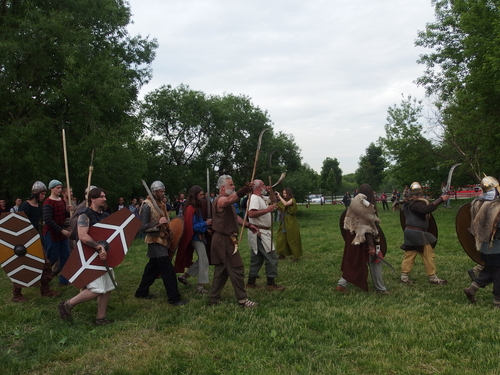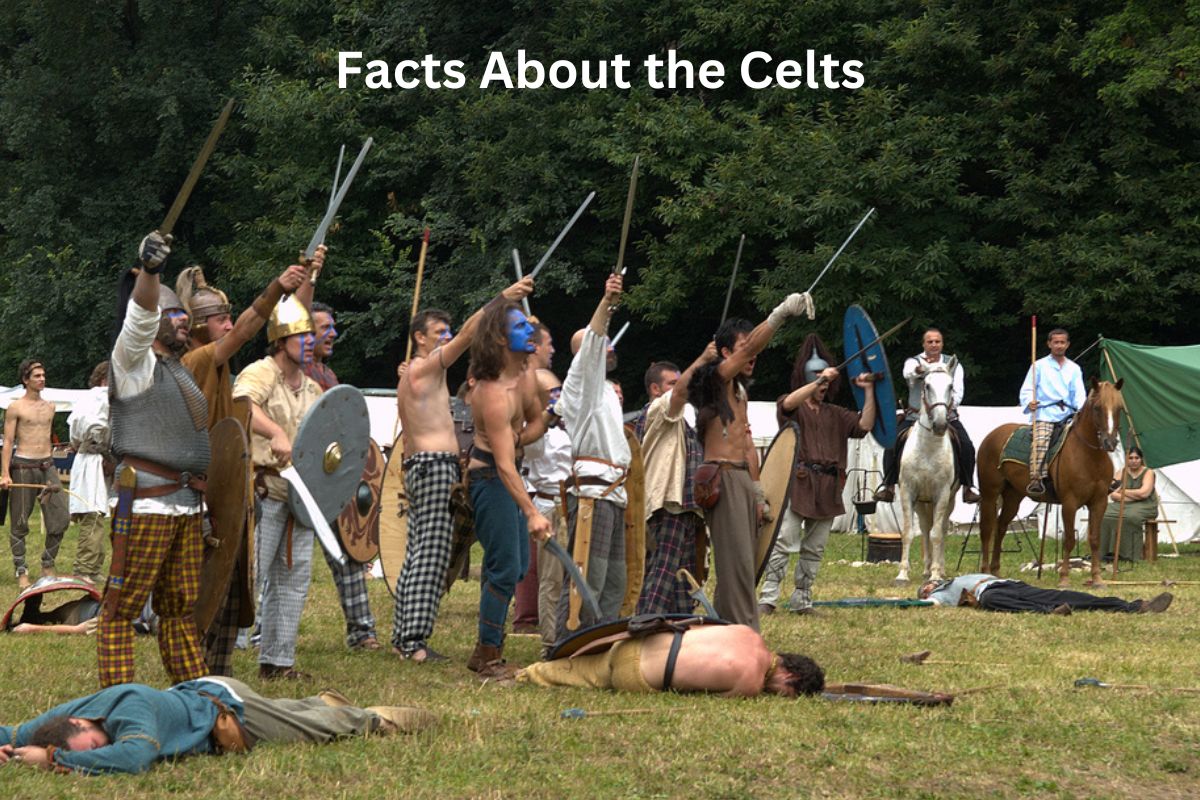The Celts were an ancient and diverse group of tribal societies that thrived in Europe from around the 8th century BCE to the 1st century CE.
They inhabited a wide range of regions, including Ireland, Scotland, Wales, England, France, Spain, and parts of central Europe.
Known for their rich culture, distinctive art, and complex religious practices, the Celts left a lasting impact on the history and heritage of Europe.
This introductory overview provides a glimpse into the fascinating world of the Celts, whose legacy continues to influence various aspects of modern society.
Celts Facts
1. Diverse ancient European tribes
The Celts were not a single, homogenous group but a collection of various tribes and cultures spread across Europe.
Also Read: Celts Timeline
These tribes shared some common cultural and linguistic elements but were often distinct from one another. They inhabited regions such as:
- Ireland
- Scotland
- Wales
- England
- France
- Spain
- Parts of central Europe
Each Celtic tribe had its own customs, leaders, and territories, which contributed to the diversity within Celtic culture.
2. Spoke Celtic languages
The Celts spoke a family of languages known as Celtic languages. These languages can be further divided into two main groups: Goidelic (or Gaelic) languages and Brythonic languages.
Also Read:
Goidelic languages include Irish, Scottish Gaelic, and Manx, while Brythonic languages include Welsh, Cornish, and Breton. Each of these languages had its own unique characteristics, but they all shared common roots and influences from earlier Celtic languages.

3. Druids were their religious leaders
Druids were a prominent and respected class of individuals in Celtic society. They served as priests, scholars, advisors, and religious leaders. Druids played a central role in the spiritual and social life of the Celts, overseeing religious rituals, ceremonies, and festivals.
They were responsible for preserving and passing down oral traditions, including myths and histories. Druids were also seen as mediators and arbitrators in disputes among Celtic tribes and often held significant political influence.
Druids were known for their deep knowledge of nature, the cosmos, and the spiritual world. They conducted their rituals in sacred groves and were believed to possess mystical and magical powers.
Their practices and teachings were often transmitted orally, and as a result, much of what is known about the Druids today comes from the writings of classical authors like Julius Caesar and later medieval sources.
4. Known for intricate Celtic art
Celtic art is renowned for its intricate and distinctive designs. It encompasses a wide range of artistic expressions, including metalwork, jewelry, illuminated manuscripts, and stone carvings. Some key features of Celtic art include:
- Celtic Knots: These are perhaps the most iconic elements of Celtic art. Celtic knots are elaborate patterns of interwoven lines with no clear beginning or end. They often symbolize eternity and the interconnectedness of life.
- Animal Motifs: Many Celtic designs incorporate stylized animal forms, such as the Celtic zoomorphic art, where animals are depicted with exaggerated, abstract features. These animals often hold symbolic significance.
- Spirals and Geometric Shapes: Celtic art frequently uses spirals, triangles, circles, and other geometric shapes in intricate patterns. These shapes can represent various concepts, from cycles of life to the elements of nature.
- La Tène Style: During the La Tène period (from the 5th century BCE onwards), a distinctive style of Celtic art emerged in Europe, characterized by ornate decoration on weapons, jewelry, and everyday objects.
5. Fierce warriors with unique weaponry
The Celts were known for their prowess in battle, and their warriors were a formidable force in ancient Europe. Some notable aspects of Celtic warriors and their weaponry include:
- Longswords: Celtic warriors often wielded longswords, which were designed for both slashing and thrusting. These swords were finely crafted and were a symbol of status and honor.
- Spears: Spears were a common weapon among the Celts, used for thrusting and throwing. They were typically made of wood and iron and were highly effective in battle.
- Shields: Celtic shields were typically circular and made from wood and animal hide. They provided protection in close combat and often featured decorative designs.
- War Paint: Before battle, Celtic warriors often painted themselves with woad, a blue dye derived from a plant. This not only served a practical purpose by providing some protection against the elements but also had symbolic and ritualistic significance.

6. Polytheistic religion with gods and goddesses
Celtic religion was polytheistic, meaning it involved the worship of multiple gods and goddesses. Some key elements of Celtic religious beliefs include:
- Nature Worship: The Celts had a deep connection with nature and believed in the spiritual significance of natural elements such as trees, rivers, and sacred groves. Many deities were associated with natural phenomena.
- Gods and Goddesses: Celtic mythology featured a pantheon of deities, each with specific attributes and domains. For example, Lugh was a god associated with skills and crafts, while Brigid was a goddess of fertility and healing.
- Rituals and Sacrifices: Celtic religious practices included rituals, offerings, and sometimes animal or human sacrifices. These were often conducted by Druids during important festivals and ceremonies.
- Afterlife Beliefs: The Celts had beliefs about the afterlife, which varied among different Celtic tribes. Some believed in an otherworldly realm, while others had ideas about reincarnation.
- Festivals: Celtic religion was marked by seasonal festivals, such as Samhain (the precursor to Halloween) and Beltane, which celebrated the changing of seasons and the cycles of life.
- Stone Circles and Sacred Sites: The Celts constructed stone circles and other sacred sites for religious ceremonies and observances. These sites, like Stonehenge, continue to be associated with Celtic spirituality and mystery.
7. Migrations and interactions with Romans
The Celts were involved in several significant migrations and interactions with the Roman Empire:
- Gallic Wars: One of the most famous interactions between the Celts and the Romans was the Gallic Wars (58-50 BCE) led by Julius Caesar. Caesar’s campaigns in Gaul (modern-day France) were aimed at subduing the Celtic tribes in the region. The Battle of Alesia in 52 BCE was a major confrontation in this conflict.
- Celtic Expansion: Prior to Roman encounters, the Celts themselves had conducted migrations and invasions. In the 4th and 3rd centuries BCE, Celtic tribes, particularly the Gauls, expanded into areas that now comprise modern-day Italy, Balkans, and Anatolia.
- Romanization: Over time, the Roman Empire assimilated many Celtic territories, leading to the Romanization of Celtic culture. This influence can still be seen in aspects of modern European culture, including language, architecture, and governance.
8. Decline due to Roman conquest and Christianity
The decline of Celtic culture can be attributed to various factors:
- Roman Conquest: The Roman conquest of Celtic lands, especially in Gaul and Britain, resulted in the suppression of Celtic tribal identities and the spread of Roman culture and governance. The Celtic regions became provinces of the Roman Empire.
- Christianity: The spread of Christianity throughout the Celtic world, particularly in Ireland and Britain, contributed to the decline of Celtic pagan religions. St. Patrick, for example, played a crucial role in Christianizing Ireland in the 5th century CE.
- Cultural Assimilation: Over time, Celtic culture became increasingly assimilated into the broader European framework, leading to the loss of distinct Celtic customs and practices.
- Anglo-Saxon Invasions: In Britain, the arrival of Anglo-Saxon and Viking invaders further eroded Celtic influence and control, pushing the Celtic peoples to the fringes of the island, particularly in Cornwall, Wales, and Scotland.
9. Modern Celtic identity in specific regions
Despite the historical challenges, Celtic identity remains strong in certain regions:
- Ireland and Scotland: In Ireland and Scotland, Celtic culture and language are still vibrant. Irish (Gaelic) and Scottish Gaelic are official languages, and there’s a revival of interest in Celtic traditions, music, and folklore.
- Wales: Welsh culture and language are integral to Wales’ identity. The Welsh language has experienced a resurgence, and the country celebrates its Celtic heritage through festivals and cultural events.
- Cornwall: In Cornwall, there’s a strong sense of Celtic identity, with the preservation of the Cornish language and the celebration of Cornish traditions.
- Brittany: In Brittany, France, there’s a distinct Celtic identity, with Breton being spoken alongside French, and Celtic festivals like Fest Noz are celebrated.
10. Famous for Celtic knots and symbols
- Celtic art is known for its intricate designs and symbols, some of which have become iconic:
- Celtic Knots: These interlocking patterns symbolize eternity and the interconnectedness of life. They are often found in jewelry, manuscripts, and other decorative items.
- Triquetra: A triple-knot design often associated with the Holy Trinity in Christianity but with roots in Celtic symbolism.
- Triskele: A motif featuring three spirals or three legs, representing various concepts including life, death, and rebirth.
- Celtic Cross: A cross with a circle around the intersection, representing the union of Christianity and Celtic spirituality.
- Spirals: Celtic art often incorporates spirals, which can symbolize growth, cycles, and the natural world.
- Animal Symbols: Stylized animal forms, like the Celtic zoomorphic art, are also prevalent in Celtic designs, with animals such as dragons, birds, and horses often depicted.
These symbols have transcended their historical significance and continue to be used in various contexts, from tattoos to modern jewelry, as a way to celebrate and connect with Celtic heritage.
